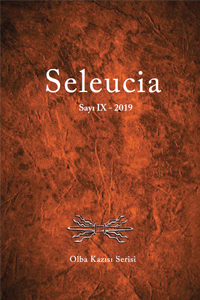Genius Loci: Towards a Roman Understanding of Carthage
Scipio Aemilianus’un önderliğinde Roma güçleri MÖ 146 yılında Kartaca’yı fethettiklerinde, bu olay Üçüncü Pön Savaşı’nın sona erişini yansıtmakta; kent de yerle bir duruma gelmekteydi. O yerin ruhu ya da genius loci, tahribatın yapıldığı anda kentin fiziksel varlığını terk etmekte, bundan sonra artık Roma’nın bir temsilcisi ve belleği haline gelmekteydi. Romalı izleyiciler için Kartaca’nın görünümü sadece zafer tören alaylarında canlandırıldığı biçimiyle vardı. Bu törenler, İkinci ve Üçüncü Pön Savaşları sonrasında kutlananlar ya da M. Valerius Messala ve L. Hostilius Mancinus’un anılarına adanan resimlere yansıyanlarla sınırlıydı. Roma’nın Kartaca’ya duyduğu hayranlık, kentin Augustus Dönemi’nde yeniden inşa edilmesini sağladı. Colonia Concordia Iulia Karthago adı ile yeniden kurulan kentte Augustus sadece sıradan bir Roma koloni kurmuyor; ya da onun Pön geçmişini silip atmıyordu. Aksine, Vergilius’un Aeneas Destanı’ndan aldığı mitolojik esinle, İmparator kendi efsanevi atası olan Aeneas tarafından başlanan bir görevi tamamlamaktaydı. Roma’nın yeni Kartaca kenti bir genius loci merkezinde gelişiyor, Roma belleğini asırlar boyunca yaşatıyor ve tarihsel paralelleriyle bütünleşiyordu.
Anahtar Kelimeler:
Kartaca, Roma, Augustus, Genius loci, Roma Belleği, Yerleşim Tarihi
Genius Loci: Towards a Roman Understanding of Carthage
In 146 BCE, Scipio Aemilianus and his Roman forces conquered Carthage at the conclusion of the Third Punic War and laid waste to the city. The genius loci, or spirit of place, that had emanated from the physical site transitioned at the moment of destruction and became a production of Roman representation and memory. One means of portraying Carthage to a Roman audience was through triumphal processions, such as those of the Scipii following the Second and Third Punic Wars or commemorative paintings such as those of M. Valerius Messala and L. Hostilius Mancinus. The Roman fascination with Carthage led to the city’s ultimate rebuilding under Augustus. In re-founding the city as Colonia Concordia Iulia Karthago, he did not simply build another Roman colony, nor did he wipe away any trace of the Punic past. Rather, aided by the mythological narrative provided by Vergil’s Aeneid, Augustus completed a task begun by his legendary ancestor, Aeneas, and built a new Roman Carthage, centered around a genius loci growing in Roman memory for centuries and complete with historical parallels to Rome.
Keywords:
Carthage, Rome, Augustus, Genius loci, Roman memory, Urban history,
___
- Appian Appian’s Roman History (translated by H. White). 4 vols., Loeb Classical Library. Cambridge: Harvard University Press, 1912. Beard 2007
- Beard, M., The Roman Triumph. Cambridge: Belknap Press of Harvard University Press, 2007. Certau 1984
- Certeau, M.de., The Practice of Everyday Life (translated by S. Rendall). Minneapolis: University of Minnesota Press, 1984. Connerton 1989
- Connerton, P. How Societies Remember. New York: Cambridge University Press, 1989.
- Diodorus Diodorus of Sicily (translated by F.R. Walton). 12 vols., Loeb Classical Library. Cambridge: Harvard University Press, 1947. Favro 1996
- Favro, D., The Urban Image of Augustan Rome. New York: Cambridge University Press, 1996. Galinsky 2005
- Galinsky, K. The Cambridge Companion to the Age of Augustus. New York: Cambridge University Press, 2005. Halbwachs 1992
- Halbwachs, M. On Collective Memory (translated by L.A. Coser). Chicago: University of Chicago Press, 1992. Holliday 1997
- Holliday, P., “Roman Triumphal Painting: Its Function, Development, and Reception”. College Art Association 79 (1997). Miles 2010
- Miles, R. Carthage Must be Destroyed: The Rise and Fall of an Ancient Civilization. London: Allen Lane, 2010. Norberg-Schulz 1980
- Norberg-Schulz, C., Genius Loci: Towards a Phenomenology of Architecture. New York: Rizzoli, 1980. Östenberg 2009
- Östenberg, I. Staging the World: Spoils, Captives, and Representations in the Roman Triumphal Procession. Oxford: Oxford University Press, 2009. Pedley 1980
- Pedley, J.G. New Light on Ancient Carthage: Papers of a Symposium. Ann Arbor: University of Michigan Press, 1980.
- Pliny Natural History (translated by W.H.S. Jones, H. Rackham and D.E. Eichholz). 10 vols., Loeb Classical Library. Cambridge: Harvard University Press, 1947.
- Polybius The Histories (translated by W.R. Paton). 6 vols., Loeb Classical Library. Cambridge: Harvard University Press, 1972.
- Strabo Geography (translated by H.L. Jones). 8 vols., Loeb Classical Library. Cambridge: Harvard University Press, 1966. Wilkins 1996
- Wilkins, J., ed. Approaches to the Study of Ritual: Italy and the Ancient Mediterranean: Being a Series of Seminars Given at the Institute of Classical Studies School of Advanced Study, University of London. London: Accordia Research Centre, 1996.
- ISSN: 2148-4120
- Başlangıç: 2011
- Yayıncı: Bilgin Kültür Sanat Yayınevi
Sayıdaki Diğer Makaleler
Kuşadası, Kadıkalesi/Anaia Kazısı 2007-2010 Sezonu Cam Buluntuları “Pencere Camları"
Silifke Müzesi’nden Erken Bizans Dönemine Ait Gümüş Tılsım
Olba’da Şeytanderesi Vadisi’ndeki Kaya Kült Alanında Bulunan Unguentariae
Osmanlı’nın Arkeoloji Algısı: Kilikia Örneği
Erken Hıristıyanlık Döneminde Cilicialı Şifavericiler: Dioscorides, Cosmas ve Damianus
Anadolu’da Kadın: On Bin Yıldır Eş, Anne, Tüccar, Kraliçe
